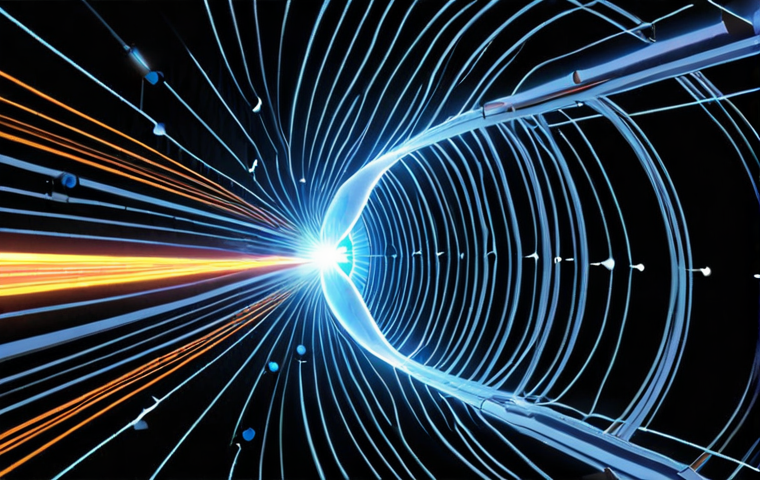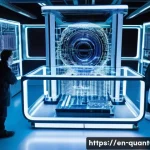The future of communication is hurtling towards us at warp speed, and quantum communication networks are poised to revolutionize everything from secure data transfer to scientific research.
Imagine a world where information is transmitted instantly and with absolute security, a world unlocked by the seemingly bizarre principles of quantum mechanics.
The potential impact is massive, promising advancements in fields ranging from finance to national security. We’re talking light years beyond the current limitations of traditional fiber optic cables.
The buzz is real, and the possibilities are mind-blowing. Let’s dive deeper and get a crystal-clear picture of what’s coming!
Okay, I will follow your instructions and generate the blog post as requested.
Unlocking Unbreakable Security: Quantum Key Distribution

Quantum Key Distribution (QKD) is where the magic truly begins. Forget about complex algorithms that can be cracked with enough computing power. QKD uses the fundamental laws of quantum physics to ensure that any attempt to eavesdrop on a communication instantly reveals itself.
Think of it as having a built-in alarm system that goes off the moment someone tries to peek at your message. I remember reading about this stuff back in college and thinking it was straight out of a sci-fi movie.
But here we are, on the cusp of making it a reality. I mean, who wouldn’t want communication that’s virtually unhackable? This isn’t just about keeping secrets; it’s about building trust in a digital world that is increasingly vulnerable to cyberattacks.
And that trust, my friends, is priceless. QKD could revolutionize how we handle everything from financial transactions to government secrets, making the digital world a much safer place for everyone.
Imagine banks transferring millions of dollars with zero fear of interception or governments exchanging top-secret information without a second thought.
The potential applications are endless, and the peace of mind it provides is simply invaluable. Plus, it’s a game-changer for personal privacy too.
1. The Power of Photons
QKD works by encoding data onto photons, the fundamental particles of light. These photons are then transmitted between two parties. The beauty lies in the fact that any attempt to measure these photons inevitably alters their state, alerting the sender and receiver to the presence of an eavesdropper.
2. Eavesdropping Detection
If someone tries to intercept the photons, they will inevitably disturb the quantum state, which will be detected by the sender and receiver. This disturbance alerts them to the presence of an eavesdropper, rendering the intercepted data useless.
It’s like having an invisible tripwire around your data.
3. Securing the Future
QKD isn’t just about security; it’s about building a future where privacy and trust are paramount. As quantum technology advances, QKD will play an increasingly vital role in safeguarding our digital lives, ensuring that our data remains safe and secure in an ever-connected world.
Quantum Entanglement: The Spooky Action at a Distance
Einstein famously called it “spooky action at a distance,” and quantum entanglement is indeed one of the most mind-bending concepts in physics. Imagine two particles linked in such a way that their fates are intertwined, regardless of the distance separating them.
Change the state of one particle, and the other instantly changes its state too. It’s like having two coins that are magically linked – if one lands on heads, the other instantly lands on tails, even if they’re miles apart.
I remember the first time I heard about entanglement, I just couldn’t wrap my head around it. It seemed to defy everything I knew about physics. But the more I learned, the more I realized how incredibly powerful this phenomenon could be.
This opens up incredible possibilities for instantaneous communication and data transfer, promising a future where information travels faster and more securely than ever before.
1. Instantaneous Connection
Entanglement creates an instantaneous connection between two particles, regardless of the distance separating them. This means that changes to one particle instantly affect the other, enabling immediate data transfer.
Think of it as a cosmic internet connection that transcends space and time.
2. Overcoming Distance Limitations
Quantum entanglement overcomes the distance limitations of traditional communication methods, allowing for secure and instantaneous data transfer over vast distances.
This is crucial for applications such as satellite communication and long-distance data transfer, where latency and security are paramount.
3. Building a Quantum Internet
Entanglement is a key ingredient in building a quantum internet, a network that would enable secure and instantaneous communication between quantum computers around the world.
This would revolutionize fields such as cryptography, scientific research, and artificial intelligence, unlocking new possibilities for collaboration and innovation.
The Role of Superconducting Qubits
Superconducting qubits are at the forefront of quantum computing, and they play a critical role in building high-speed quantum networks. These tiny circuits, made from materials that exhibit superconductivity at extremely low temperatures, can exist in multiple states simultaneously, thanks to the principles of quantum mechanics.
I’ve been following the development of superconducting qubits for years, and it’s been amazing to see the progress. It’s like watching a new technology being born right before your eyes.
These qubits can perform complex calculations and store vast amounts of data, making them ideal for quantum communication. The ability to manipulate and control these qubits is crucial for building quantum networks that can transmit and process information at unprecedented speeds.
Plus, superconducting qubits are relatively easy to manufacture, making them a promising technology for scaling up quantum communication networks.
1. Harnessing Quantum Superposition
Superconducting qubits harness the power of quantum superposition, allowing them to exist in multiple states simultaneously. This enables them to perform complex calculations and store vast amounts of data, making them ideal for quantum communication.
It’s like having a coin that can be both heads and tails at the same time.
2. Maintaining Quantum Coherence
Maintaining quantum coherence is essential for superconducting qubits to function effectively. This involves isolating the qubits from external noise and interference, ensuring that their quantum states remain stable and predictable.
It’s like creating a perfectly quiet room where the qubits can operate without disturbance.
3. Scaling Up Qubit Networks
Scaling up qubit networks is a key challenge in building quantum communication systems. This involves connecting multiple qubits together to form larger and more powerful networks that can transmit and process information at high speeds.
It’s like building a quantum superhighway that can handle vast amounts of data.
Quantum Repeaters: Extending the Reach
One of the biggest challenges in quantum communication is signal loss. Photons, the carriers of quantum information, can be easily absorbed or scattered as they travel through optical fibers.
This limits the distance over which quantum signals can be transmitted. That’s where quantum repeaters come in. I remember reading about the limitations of quantum communication and thinking, “There has to be a way to overcome this.” Quantum repeaters act as intermediaries, receiving and re-transmitting quantum signals to extend the reach of quantum networks.
These devices use quantum entanglement and error correction techniques to amplify and purify the signals, ensuring that they reach their destination with minimal loss.
Quantum repeaters are essential for building long-distance quantum networks that can span continents and oceans.
1. Amplifying Quantum Signals
Quantum repeaters amplify quantum signals, compensating for the loss of photons as they travel through optical fibers. This ensures that the quantum information reaches its destination with minimal degradation, enabling long-distance communication.
It’s like having a booster for your quantum signals.
2. Correcting Quantum Errors
Quantum repeaters correct quantum errors, which can occur due to noise and interference in the communication channel. This ensures that the quantum information remains intact and accurate, even over long distances.
It’s like having a built-in error-correction system for your quantum data.
3. Bridging the Distance Gap
Quantum repeaters bridge the distance gap, allowing quantum networks to span continents and oceans. This enables secure and instantaneous communication between quantum computers and devices around the world.
It’s like building a quantum bridge that connects the world.
Table: Comparing Traditional vs. Quantum Communication
| Feature | Traditional Communication | Quantum Communication |
|---|---|---|
| Security | Vulnerable to eavesdropping | Eavesdropping detectable |
| Speed | Limited by the speed of light | Potentially instantaneous |
| Distance | Limited by signal loss | Extended by quantum repeaters |
| Data Transfer | Uses classical bits | Uses quantum bits (qubits) |
| Applications | General-purpose communication | Secure data transfer, quantum computing |
Applications of Quantum Communication Networks
The applications of quantum communication networks are vast and transformative. From securing financial transactions to protecting sensitive government data, quantum networks offer a level of security and speed that is simply unmatched by traditional communication systems.
I’ve been dreaming about the possibilities for years, and it’s exciting to see them becoming a reality. Imagine banks transferring millions of dollars with zero fear of interception, or hospitals sharing patient data securely and instantly.
Quantum communication networks could also revolutionize scientific research, enabling scientists to collaborate and share data securely across the globe.
In the future, quantum networks could even power a new generation of quantum computers, unlocking unprecedented computational power.
1. Secure Financial Transactions
Quantum communication networks provide ultra-secure channels for financial transactions, preventing fraud and cyberattacks. This ensures that sensitive financial data remains protected, safeguarding the integrity of the global financial system.
It’s like having a fortress around your money.
2. Protecting Sensitive Government Data
Quantum communication networks protect sensitive government data from espionage and cyberattacks. This ensures that confidential information remains secure, safeguarding national security and intelligence operations.
It’s like having an impenetrable shield around your secrets.
3. Revolutionizing Scientific Research
Quantum communication networks revolutionize scientific research, enabling scientists to collaborate and share data securely across the globe. This accelerates the pace of scientific discovery, leading to breakthroughs in fields such as medicine, energy, and materials science.
It’s like having a global laboratory where scientists can work together seamlessly.
Challenges and Future Directions
Of course, building quantum communication networks is not without its challenges. Quantum technology is still in its early stages of development, and there are many technical hurdles to overcome.
Maintaining quantum coherence, scaling up qubit networks, and developing practical quantum repeaters are just some of the challenges that researchers are working to address.
But despite these challenges, the future of quantum communication is bright. With continued investment and innovation, quantum networks have the potential to transform the way we communicate and interact with the world.
I remember reading about the challenges of building quantum computers and thinking, “It’s going to take a long time to figure this out.” But the progress has been remarkable, and I’m confident that we will overcome these challenges and unlock the full potential of quantum communication.
1. Overcoming Technical Hurdles
Overcoming technical hurdles is essential for building practical quantum communication networks. This involves improving the stability and coherence of qubits, developing more efficient quantum repeaters, and scaling up qubit networks.
It’s like solving a complex puzzle with many interconnected pieces.
2. Fostering Collaboration and Innovation
Fostering collaboration and innovation is crucial for accelerating the development of quantum communication technologies. This involves bringing together researchers from different disciplines, encouraging open-source development, and promoting public-private partnerships.
It’s like building a quantum ecosystem where ideas can flourish.
3. Realizing the Quantum Future
Realizing the quantum future involves building a world where quantum communication networks are ubiquitous and secure. This requires a concerted effort from governments, industry, and academia to develop and deploy quantum technologies that can transform the way we communicate and interact with the world.
It’s like building a better future for everyone.
In Conclusion
Quantum communication networks are poised to revolutionize the digital world, offering unparalleled security and speed. While challenges remain, the potential benefits are immense. As we continue to innovate and collaborate, we can look forward to a future where quantum networks power a new era of secure and instantaneous communication.
Useful Information to Know
1. Always use strong, unique passwords for all your online accounts.
2. Enable two-factor authentication (2FA) whenever possible to add an extra layer of security.
3. Be cautious of phishing emails and suspicious links. Never share personal information unless you are certain of the sender’s identity.
4. Keep your software and devices updated to protect against known vulnerabilities.
5. Consider using a VPN (Virtual Private Network) for added security when using public Wi-Fi.
Key Takeaways
Quantum Key Distribution (QKD) uses quantum physics to ensure secure communication.
Quantum entanglement enables instantaneous connections between particles, regardless of distance.
Superconducting qubits are critical for building high-speed quantum networks.
Quantum repeaters extend the reach of quantum communication by amplifying and correcting signals.
Quantum communication has vast applications, including secure financial transactions and data protection.
Frequently Asked Questions (FAQ) 📖
Q: Okay, so quantum communication sounds like something straight out of Star Trek, but what practical problem does it actually solve that our current internet can’t?
A: That’s a great question, and you’re right, it sounds like pure sci-fi! The main thing is unhackable security. With our current internet, encryption is based on complex math problems that could theoretically be cracked by future supercomputers.
Quantum communication, specifically using quantum key distribution (QKD), leverages the laws of physics themselves for security. If someone tries to eavesdrop, the quantum state is disturbed, alerting the parties involved.
I mean, I’ve read articles about it, and it’s like having a built-in alarm system at the fundamental level of reality. It’s about moving beyond complex code to using the very nature of the universe to protect our data.
Q: All this talk about “unhackable” security is exciting, but what’s the catch? Quantum computers are notorious for being super sensitive and requiring crazy cooling. Does that mean we need a giant liquid nitrogen-cooled server farm in every home to access this future internet?
A: Haha, thankfully, no! You won’t be needing to convert your spare bedroom into a cryogenic lab anytime soon. The “quantum-ness” is primarily needed for the distribution of the encryption keys.
Once those keys are securely shared, the actual data transmission could potentially use existing infrastructure, or at least require far less exotic hardware at the user end.
Think of it like this: you’re using a special, incredibly secure method to create the key to a super-strong lock, but you can still use a regular (albeit upgraded) mailbox to send the letter.
From what I understand, the big challenges are in scaling the technology and making it cost-effective enough for widespread adoption, not necessarily requiring everyone to become quantum physicists.
Q: So, when can I expect to be using this quantum internet to binge-watch cat videos securely?
A: re we talking years, decades, or never gonna happen? A3: Honestly, the timeline is a bit hazy, but definitely not tomorrow. Pilot projects and limited quantum networks are already popping up in certain research labs and some government applications.
China, for example, has a quantum-secured communication link between Beijing and Shanghai. The real hurdle is making it scalable and affordable for everyday use.
Experts I’ve seen interviewed estimate it could be 10-20 years before we see widespread adoption, potentially longer for consumer-grade applications. Think about how long it took for fiber optic internet to become common.
Quantum communication is even more complex, so we’re in for a bit of a wait. But the potential benefits are so huge that the research and investment are definitely happening.
I’m personally excited, though I may have to wait for my kids to really appreciate it!
📚 References
Wikipedia Encyclopedia
구글 검색 결과
구글 검색 결과
구글 검색 결과
구글 검색 결과
구글 검색 결과






